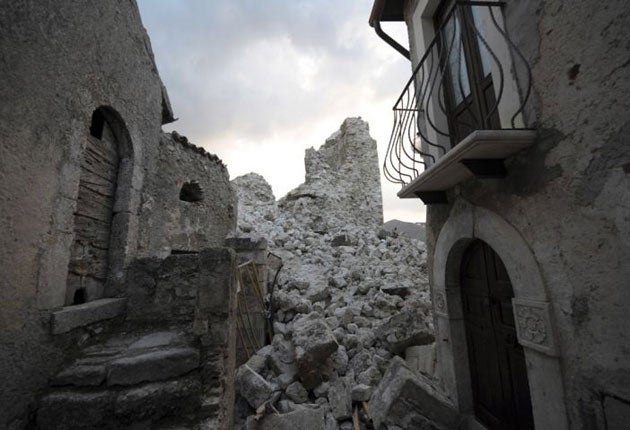The little village that defied the earthquake
Santo Stefano di Sassanio somehow still stands – and is a symbol of hope for the future of the shattered region of Abruzzo

The earthquake that laid waste to the city of L'Aquila last Monday also shook the mountain village of Santo Stefano di Sassanio to its foundations. The fault on which the quake occurred runs underneath the village, and the violent shocks reduced its 15th-century tower to a heap of rubble. But the remarkable thing about this village is not what fell down, but what stood up, and why. Apart from the tower, no other structure was damaged. And the reasons for that send a message of hope and inspiration to the rest of the shattered Abruzzo region, for this is the story of the little village that defied the earthquake.
Olivio di Gregorio, a structural engineer, was shaken from his sleep by the earthquake. He jumped into his car and by five o'clock was in the village. Impatiently he waited for dawn, and when it came his urgent question was answered: Santo Stefano had passed its toughest test. With the dramatic exception of the tower, it had survived intact. Probing inside the medieval stone homes on whose painstaking restoration he has been working for years, he discovered that the news was even better: they had come through with barely a scratch.
Santo Stefano offers lessons of profound importance to the Abruzzo region in its moment of grave crisis. It proves that the ancient architectural splendour of the region, much of it battered and bruised by the quake, can be brought back to life with the right balance of sensitivity and technology.
Why did Santo Stefano's tower collapse? And why did the newly restored medieval houses come through undamaged? For Lelio Oriano di Zio, the architect behind the village's restoration, and Daniele Kihlgren, who financed it, the explanation of these events is the key to understanding how Abruzzo can be reborn.
Founded in Roman times, Santo Stefano became a centre of the wool trade during the Medici era, and prospered accordingly. But after Italy's unification in the 19th century, it lost its economic role, and after the Second World War it was practically abandoned.
Ten years ago Oriano di Zio and Kihlgren came together to rescue the village. They bought 15 houses, restored them with great care and launched them as Sextantio, Italy's first albergo diffuso or "scattered hotel". In the process they agreed on the basic ground rules for such a project, which they are now applying to five other ancient villages in central Italy.
"We understood that the restoration of the village must go hand in hand with the protection of the countryside," says Oriano di Zio. "We made a pact with the mayor whereby she agreed not to give permission for any new buildings, and to protect the existing ones. There are few places as beautiful as this: we say they are as important a part of Italy's patrimony as the Colosseum, and should be protected just as stringently."
But protecting the village does not mean leaving it untouched. "In restoring the houses we have obeyed the most recent anti-earthquake building codes; in fact, we have gone beyond them," says Oriano di Zio. Wooden arches are inconspicuously bracketed by stout steel girders. Upper floors hide steel reinforcement, giving the structures both the strength and flexibility to ride the seismic waves. "One can conserve historic fabric while making it structurally adequate," says Kihlgren. "It would be a crime to do otherwise. Here there are houses with trees growing inside them, with 200-year-old tiles, but which also have underfloor heating and obey the anti-earthquake codes."
But if the houses survived so well, why did the tower fall? Di Gregorio points to a large concrete slab perched on its side near the top of the pile of rubble. Some decades back, long before the present restoration got under way, a concrete platform was stuck on the crown of the tower, to afford views over the countryside. "It was like putting a slab of stone on a cardboard box," he explains. "The box holds up, but if it comes under stress the weight will make it cave in."
"After the Industrial Revolution, we lost our heritage of wisdom about how to resist earthquakes," says Oriano di Zio. "In our modern arrogance, we thought we knew best. Today the first thing we need to recover is a sense of humility."
Join our commenting forum
Join thought-provoking conversations, follow other Independent readers and see their replies
Comments
Bookmark popover
Removed from bookmarks